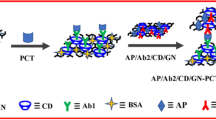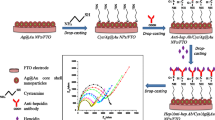Abstract
In order to determine procalcitonin, a sandwich-type ratiometic electrochemical immunosensor was developed by differential pulse voltammetry (DPV). Due to high chemical stability and good biocompatibility, graphitic carbon nitride (g-C3N4) could be used as feasible supporter to carry silver nanoparticles (Ag NPs) with an obvious oxidative peak (measured typically at + 0.3 V vs. SCE). Ag NPs loaded onto g-C3N4 were not only beneficial to prevent the agglomeration of Ag NPs, but also favorable to improve the electron transfer velocity of g-C3N4. Moreover, the g-C3N4-Ag NPs as the matrix could immobilize primary antibody by Ag–N bond. Nile blue A (NBA), an excellent redox probe based on the redox reaction with two-electrons, provides a current signal at − 0.38 V (vs. SCE). Zr-based metal organic framework (UiO-67), an ideal framework material with large specific surface area and high porosity, could absorb the substantial water-soluble NBA by electrostatic adsorption. The UiO-67 modified by NBA (NBA-UiO-67) owned admirable biocompatibility and was a qualifying marker to load the secondary antibody. For the immunosensor, the current ratio of NBA to Ag NPs (INBA/IAg NPs) was increased as the concentrations of PCT increased. Under the optimum conditions, the linear range of the immunosensor was 0.005 to 50 ng/mL; the detection limit was 1.67 pg/mL (S/N = 3), which reflected the excellent analytical performance of the sensor. The proposed immunosensor strategy is a simple and dependable platform, with great application potential in biometric analysis.
Graphical abstract





Similar content being viewed by others
References
Bouadma L, Luyt C-E, Tubach F, Cracco C, Alvarez A, Schwebel C, Schortgen F, Lasocki S, Veber B, Dehoux M, Bernard M, Pasquet B, Régnier B, Brun-Buisson C, Chastre J, Wolff M (2010) Use of procalcitonin to reduce patients’ exposure to antibiotics in intensive care units (PRORA TA trial): a multicentre randomised controlled trial. Lancet 375:463–474
Li YK, Liu W, Jin G, Niu Y, Chen YP, Xie MX (2018) Label-free sandwich imaging ellipsometry immunosensor for serological detection of procalcitonin. Anal Chem 90:8002–8010
Tang BMP, Eslick GD, Craig JC, Mclean AS (2007) Accuracy of procalcitonin for sepsis diagnosis in critically ill patients: systematic review and meta-analysis. Lancet Infect Dis 7:210–217
Schneider H-G, Lam QT (2007) Procalcitonin for the clinical laboratory: a review. Pathology 39:383–390
Sui YY, Xu AG, Jin XR, Zheng J, He X, Cheng Y, Xie QJ, Liu RS (2018) In situ enzymatic generation of gold for ultrasensitive amperometric sandwich immunoassay of procalcitonin. Biosens Bioelectron 117:422
Zhao Y, Zhou CH, Wu RL, Shen HB, Li LS (2015) Preparation of multi-shell structured fluorescent composite nanoparticles for ultrasensitive human procalcitonin detection. RSC Adv 5:5988–5995
Liao T, Yuan F, Yu HY, Li ZG (2016) An ultrasensitive ELISA method for the detection of procalcitonin based on magnetic beads and enzyme-antibody labeled gold nanoparticles. Anal Methods 8:1577–1585
Li FY, Feng JH, Gao ZQ, Shi L, Wu D, Du B, Wei Q (2019) Facile synthesis of Cu2O@ TiO2-PtCu nanocomposites as a signal amplification strategy for the insulin detection. ACS Appl Mater Inter 11:8945–8953
Peng KF, Xie P, Yang ZH, Yuan R, Zhang KQ (2017) Highly sensitive electrochemical nuclear factor kappa B aptasensor based on target-induced dual-signal ratiometric and polymerase-assisted protein recycling amplification strategy. Biosens Bioelectron 102:282–287
Wang YG, Zhao GH, Zhang Y, Pang XH, Cao W, Du B, Wei Q (2018) Sandwich-type electrochemical immunosensor for CEA detection based on Ag/MoS2@Fe3O4 and an analogous ELISA method with total internal reflection microscopy. Sensor Actuat B-Chem 266:561–569
Ren KW, Wu J, Yan F, Zhang Y, Ju HX (2015) Immunoreaction-triggered DNA assembly for one-step sensitive ratiometric electrochemical biosensing of protein biomarker. Biosens Bioelectron 66:345–349
Liu LL, Tai XS, Zhou XJ, Liu L, Zhang X, Ding LY, Zhang YC (2020) Au–Pt bimetallic nanoparticle catalysts supported on UiO-67 for selective 1,3-butadiene hydrogenation. J Taiwan Inst Chem Eng 114:220–227
Dai G, Li Z, Luo FF, Ai AY, Chen B, Wang QJ (2019) Electrochemical determination of Salmonella typhimurium by using aptamer-loaded gold nanoparticles and a composite prepared from a metal-organic framework (type UiO-67) and graphene. Microchimica Acta 186:620
Xie HZ, Dong J, Duan JL, Hou JY, Ai SY, Li XY (2019) Magnetic nanoparticles-based immunoassay for aflatoxin B1 using porous g-C3N4 nanosheets as fluorescence probes. Sensor Actuat B-Chem 278:147–152
Sun B, Dong J, Cui L, Feng TT, Zhu JJ, Liu XH, Ai SY (2019) A dual signal-on photoelectrochemical immunosensor for sensitively detecting target avian viruses based on AuNPs/g-C3N4 coupling with CdTe quantum dots and in situ enzymatic generation of electron donor. Biosens Bioelectron 124–125:1–7
Nagajyothi PC, Pandurangan M, Vattikuti SVP, Tettey CO, Sreekanth TVM, Shim J (2017) Enhanced photocatalytic activity of Ag/g-C3N4 composite. Sep Puri Technol 188:228–237
Ren XL, Meng XW, Chen D, Tang FQ, Jiao J (2005) Using silver nanoparticle to enhance current response of biosensor. Biosens Bioelectron 21:433–437
Xu R, Lu P, Wu B, Wang XP, Pang XH, Du B, Fan DW, Wei Q (2018) Using SiO2/PDA-Ag NPs to dual-inhibited photoelectrochemical activity of CeO2-CdS composites fabricated a novel immunosensor for BNP ultrasensitive detection. Sensor Actuat B-Chem 274:349–355
Guo Q, Zhang CW, Zhang CF, Xin S, Zhang PC, Shi QF, Zhang DW, You Y (2020) Co3O4 modified Ag/g-C3N4 composite as a bifunctional cathode for lithium-oxygen battery. J Energy Chem 41:185–193
Gowthaman NSK, Lim HN, Balakumar V, Shankar S (2020) Ultrasonic synthesis of CeO2@organic dye nanohybrid: environmentally benign rabid electrochemical sensing platform for carcinogenic pollutant in water samples. Ultrason sonochem 61:104828
Duong HD, Shin Y, Rhee JI (2020) Development of novel optical pH sensors based on coumarin 6 and nile blue A encapsulated in resin particles and specific support materials. Mat Sci Eng C-Mater 107:110323
Kurouski D, Mattei M, Duyne RPV (2015) Probing redox reactions at the nanoscale with electrochemical tip-enhanced Raman spectroscopy. Nano lett 15:7956–7962
Zhao GH, Wang YG, Li XJ, Dong X, Wang H, Du B, Cao W, Wei Q (2018) Quenching electrochemiluminescence immunosensor based on resonance energy transfer between ruthenium (II) complex incorporated in the UiO-67 metal–organic framework and gold nanoparticles for insulin detection. ACS Appl Mater Inter 10:22932–22938
Xu HT, Li YS, Luo XK, Xu ZL, Ge JP (2017) Monodispersed gold nanoparticles supported on a zirconium-based porous metal–organic framework and their high catalytic ability for the reverse water–gas shift reaction. Chem Commun 53:7953–7956
Zhang DW, Zhao J, Liu QL, Xia ZG (2019) Synthesis and luminescence properties of CsPbX3@ Uio-67 composites toward stable photoluminescence convertors. Inorg Chem 58:1690–1696
Zhu XY, Li B, Yang J, Li YS, Zhao WR, Shi JL, Gu JL (2014) Effective adsorption and enhanced removal of organophosphorus pesticides from aqueous solution by Zr-based MOFs of UiO-67. ACS Appl Mater Inter 7:223–231
Zhu XY, Gu JL, Yang J, Wang Z, Li YS, Zhao LM, Zhao WR, Shi JL (2015) Zr-based metal–organic frameworks for specific and size-selective enrichment of phosphopeptides with simultaneous exclusion of proteins. J Mater Chem B 3:4242–4248
Fidelli AM, Karadeniz B, Howarth AJ, Huskić I, Germann LS, Halasz I, Etter M, Moon SY, Dinnebier RE, Stilinović V, Farha OK, Friščić T, Užarević K (2018) Green and rapid mechanosynthesis of high-porosity NU-and UiO-type metal–organic frameworks. Chem Commun 54:6999–7002
Lin K-YA, Lin J-T (2017) Ferrocene-functionalized graphitic carbon nitride as an enhanced heterogeneous catalyst of Fenton reaction for degradation of Rhodamine B under visible light irradiation. Chemosphere 182:54–64
Dong X, Zhao GH, Liu L, Li X, Wei Q, Cao W (2018) Ultrasensitive competitive method-based electrochemiluminescence immunosensor for diethylstilbestrol detection based on Ru(bpy)32+ as luminophor encapsulated in metal–organic frameworks UiO-67. Biosens Bioelectron 110:201–206
Pan JQ, Dong ZJ, Wang BB, Jiang ZY, Zhao C, Wang JJ, Song CS, Zheng YY, Li CR (2019) The enhancement of photocatalytic hydrogen production via Ti3+ self-doping black TiO2/g-C3N4 hollow core-shell nano-heterojunction. Appl Catal B-Environ 242:92–99
Zhao GH, Wang YG, Li XJ, Yue Q, Dong X, Du B, Cao W, Wei Q (2019) Dual-quenching electrochemiluminescence strategy based on three-dimensional metal–organic frameworks for ultrasensitive detection of amyloid-β. Anal Chem 91:1989–1996
Wang YG, Wang YL, Wu D, Ma HM, Zhang Y, Fan DW, Pang XH, Du B, Wei Q (2018) Label-free electrochemical immunosensor based o flower-like Ag/MoS2/rGO nanocomposites for ultrasensitive detection of carcinoembryonic antigen. Sensor Actuat B-Chem 255:125–132
Wu D, Wei YC, Ren X, Ji XQ, Liu YW, Guo AD, Liu ZA, Asiri AM, Wei Q, Sun XP (2018) Co(OH)2 nanoparticle-encapsulating conductive nanowires array: room-temperature electrochemical preparation for high-performance water oxidation electrocatalysis. Adv Mater 30:1705366
Acknowledgements
This study was supported by the National Key Scientific Instrument and Equipment Development Project of China (No. 21627809), the Jinan Scientific Research Leader Workshop Project (No. 2018GXRC024).
Author information
Authors and Affiliations
Corresponding author
Ethics declarations
Conflict of interest
The authors declare no competing interests.
Additional information
Publisher's note
Springer Nature remains neutral with regard to jurisdictional claims in published maps and institutional affiliations.
Supplementary Information
Below is the link to the electronic supplementary material.
Rights and permissions
About this article
Cite this article
Yue, Q., Li, X., Xu, X. et al. Ratiometric electrochemical immunoassay for procalcitonin based on dual signal probes: Ag NPs and Nile blue A. Microchim Acta 189, 126 (2022). https://doi.org/10.1007/s00604-022-05225-5
Received:
Accepted:
Published:
DOI: https://doi.org/10.1007/s00604-022-05225-5




